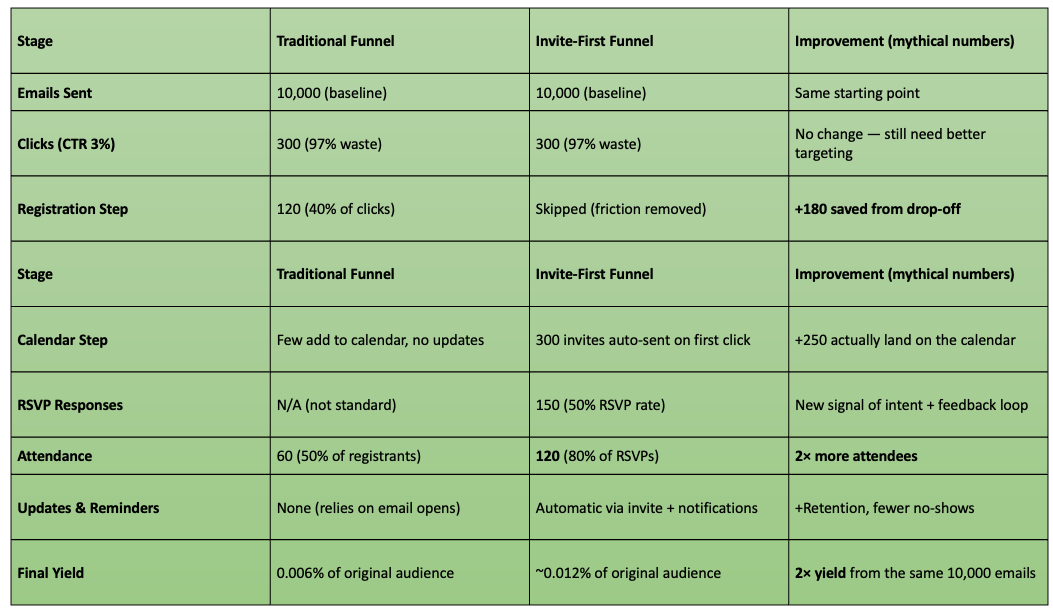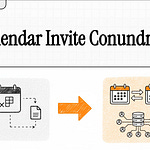What is the core concept of the "Invite-First" model?
The "Invite-First" model flips the traditional marketing funnel by prioritizing direct calendar invitations to a pre-qualified audience. Instead of relying on a series of clicks and registrations that often lead to high drop-off rates, this model aims to secure a verifiable commitment (an RSVP) from the recipient as the initial engagement, thereby capturing high-intent individuals earlier in the process.
How does the "Invite-First" model address concerns about scalability and efficacy?
Initially, concerns arose about the technical and logistical hurdles of sending calendar invitations at scale. However, the model has evolved to utilize "verified and curated lists," allowing direct calendar invites to be sent to a much larger, pre-qualified starting pool. This significantly expands the reach beyond just those who click, making it a data-backed, scalable strategy built on a cloud-native infrastructure.
How does the "Invite-First" model create a larger and more qualified starting pool compared to traditional methods?
Unlike a typical webinar funnel that might start with 10,000 emails and result in a small number of clicks, the "Invite-First" model can target a starting pool of up to 2,240 people. This is achieved by combining a standard email list (e.g., 8,000 emails resulting in 240 clicks) with a curated VIP list of 2,000 consistently engaged individuals. This ability to directly target a high-value segment transforms the calendar invite into a personalized, high-value conversion mechanism from the outset.
What are the key verifiable commitment metrics that validate the "Invite-First" theory?
Two key engagement statistics firmly validate the model:
25% RSVP Response Rate: A quarter of recipients respond with an RSVP to the calendar invites. This signifies active engagement within their personal calendar, moving beyond passive clicks.
84% Yes RSVP Rate: Of those who responded, a remarkable 84% accepted the invitation. This demonstrates the model's effectiveness in capturing a high-intent segment and converting them into genuine, scheduled commitments.
How do these verifiable commitment metrics contrast with traditional funnel metrics?
Traditional funnels primarily measure drop-off rates, highlighting inefficiency (e.g., a 99.94% waste rate). In stark contrast, the "Invite-First" funnel measures commitment. The high RSVP and acceptance rates prove that by removing friction and respecting the initial engagement, the model achieves a quality of commitment and engagement that traditional metrics cannot capture.
What technical foundation supports the "Invite-First" model?
The "Invite-First" model is not just a theoretical framework; it's built upon a fully functional, AWS-based Calendar Invite Server. This cloud-native infrastructure provides a scalable backbone for the entire operation, automating the process. Event data is captured, normalized, and stored in a database, ready to be sent on demand, triggered by a CTA link in an email or a form on a webpage, ensuring a seamless and frictionless experience.
What is the ultimate impact of the "Invite-First" model on revenue and sales pipelines?
The model acts as a "revenue multiplier." By targeting a significantly larger, pre-qualified audience with a method that consistently converts a high percentage into committed guests, it guarantees a dramatic increase in event attendance. Even with a slight degradation in attendee quality due to increased scale, the sheer growth in high-intent participants leads to a more robust and qualified sales funnel, dramatically increasing the potential for final revenue.
In summary, what is the fundamental shift offered by the "Invite-First" model?
The "Invite-First" model represents a fundamental shift from an inefficient, drop-off-focused funnel to a commitment-driven pipeline. It's not just about a more efficient process; it's about a fundamentally different way to build a pipeline of committed, high-value customers. This is achieved through a combination of increased scalability, high-intent engagement metrics, and a robust, cloud-native technical infrastructure that automates and streamlines the entire process.
The Funnel Flip Implementation Playbook
Understanding the 'Funnel Flip': A Better Way to Welcome Your Audience
Introduction: The Party Invitation Problem
Imagine you send an invitation to a great party. Someone gets excited and clicks "I'm interested!" but instead of seeing the party details, they're handed a long, tedious questionnaire to fill out before they can even say "yes." Many will simply give up and walk away. For a specific class of high-friction digital events like webinars, this is exactly how most marketing works today—it celebrates the click, then immediately creates friction that pushes interested people away.
The 'Funnel Flip' is the solution. It’s a strategic re-engineering of the event funnel—a smarter, more respectful way to engage with people who have already shown interest.
This document will explain what the Funnel Flip is, how it differs from the traditional approach, and why this change is a game-changer for customer experience. To truly appreciate this new method, we first need to understand the old, broken model it’s designed to replace.
1.0 The Old Way: The "Leaky" Marketing Funnel
The traditional marketing funnel for digital events has long been accepted as a necessary but deeply wasteful process. It's a system that is fundamentally designed to shrink at every step, losing valuable, interested people along the way.
1.1 The Path of Staggering Waste
Consider a typical marketing campaign for an online event. The numbers reveal a journey of massive, predictable loss. These numbers aren't just hypothetical; they reflect documented industry averages for email CTR and form completion rates.
Emails Sent: 10,000
The campaign starts with a broad outreach.
Clicks: 300
A standard 3% click-through rate means 97% of the audience is lost immediately.
Registrations: 120
Of those who clicked, 60% drop off at the registration form, the single biggest point of friction.
Final Attendance: 60
Finally, only 50% of registrants typically attend the live event.
The final yield from an initial audience of 10,000 is a mere 60 people, or 0.006%. This represents a colossal 99.994% of wasted effort. The source material accurately describes this outcome as a process of "staggering waste."
1.2 The Core Problem: Punishing People Who Click
Here's the deep, philosophical flaw that most marketers miss: the traditional funnel is designed to "celebrate the click, then punish the person who clicked." The moment someone shows interest, they are immediately met with a high-friction registration form that works against both the user and the business.
This post-click friction has two major negative consequences:
It Filters for Patience, Not Interest: By creating a difficult user journey, the funnel mistakenly selects for the most patient prospects—those willing to persevere through a clunky process. It fails to select for the most interested ones, which is a critical strategic error in identifying genuine buying intent.
It Kills Lead Quality: This misalignment delivers poor-quality leads to the sales team. Focusing on a volume of "registrants" who may not be truly interested drains sales resources, damages the brand's reputation, and can plummet team morale.
The Funnel Flip was designed as a direct solution to these core problems by completely rethinking this initial interaction.
2.0 The New Way: Flipping the Funnel on its Head
The 'Funnel Flip' offers an elegant and strategic solution by reorienting the entire process around a single, powerful shift. It doesn't just patch the leaks; it rebuilds the funnel on a stronger foundation.
2.1 A Simple and Powerful Shift: From 'Register' to 'Calendar'
The single most important change in the Funnel Flip is moving from a "Click → Register" sequence to a "Click → Calendar Invite" model.
This simple pivot completely eliminates the registration form, which is the biggest bottleneck in the traditional funnel. The moment a person clicks, they are not met with an obstacle but with an open door—a live, updateable calendar invite that automatically places the event where they manage their time.
2.2 The Power of a Calendar Invite
Using the calendar as the entry point is incredibly effective because it aligns with how people actually plan their time and signal their intentions.
It Establishes Real Commitment: A person's calendar is their "container of time," where they manage their most finite resource. Accepting a calendar invite is a tangible sign of commitment that filling out a form can never match.
It Creates a Living Connection: Unlike a static
.icsfile, which is optional, lacks real-time functionality, and must be manually downloaded, a live calendar invite creates a direct channel for communication. This allows for automatic updates, reminders, and cancellations that keep the event top-of-mind.It Removes All Friction: This approach bypasses the single biggest source of user drop-off, preserving the interest and goodwill of everyone who clicks.
Now, let's look at the quantifiable impact this strategic shift can have.
3.0 Seeing the Difference: A Side-by-Side Funnel Comparison
Let's put the theory aside and look at the numbers. This is where the strategic advantage becomes undeniable. The table below, extracted directly from the source analysis, provides a side-by-side comparison of the two models.
The Funnel Flip: A Revolutionary Digital Event Strategy
This data highlights two critical insights. First, by simply eliminating the registration step, the Funnel Flip saves 180 interested leads from immediately dropping off. Second, by leveraging the power of native calendar reminders, the final result is a projected doubling of event attendance from 60 to 120.
These numbers prove that the Funnel Flip is a better model with dramatically better results. But its benefits go beyond the numbers.
4.0 More Than a Tactic: A Shift in Mindset
The Funnel Flip is not just a technical fix; it represents a fundamental change in philosophy. It’s a strategic decision to compete on customer experience rather than brute-force lead volume. At its heart is a powerful and simple metaphor.
The core idea is about "treating people like guests, not afterthoughts."
When someone clicks a link, they are expressing interest. The traditional funnel treats them like a lead to be processed through a clunky, impersonal system. This creates a negative brand impression from the very first interaction. In contrast, the Funnel Flip welcomes them like a guest. The frictionless, respectful experience of receiving an immediate calendar invite demonstrates that your brand is reliable and values their time. This builds trust, which is a powerful strategic advantage in any market.
5.0 Your Key Takeaway
To truly master the Funnel Flip, you must distill it down to its core purpose. It's a strategic pivot away from an outdated model of data capture toward a modern model of relationship building.
As you audit your own funnels, this is the single most important mindset shift you need to make:
The Funnel Flip is about shifting your goal from capturing a lead to earning a commitment. It respects your audience's time and intent from the very first click, creating a better experience that delivers dramatically better results.









